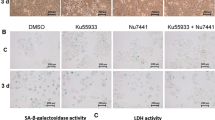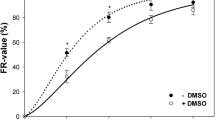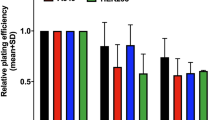Abstract
Although DNA-damaging agents such as ultraviolet (UV) and X-ray can induce apoptosis, the difference in the apoptotic mechanism is not clearly understood. In the present study, we investigated the effects of these two genotoxic agents on the induction of DNA damage and subsequent apoptotic cell death from the viewpoint of cell cycle regulation by using WiDr cells. Transient G1 arrest was observed after UV exposure, whereas G2 but not G1 arrest was induced after X-ray irradiation. UV-exposure could induce G1 arrest in both mutant-type (mt-p53) and wild-type p53 (wt-p53) cells, but obvious G1 arrest was not observed in the cells lacking in p53 expression. An increase in the DNA fragmentation was observed at S phase in UV-irradiated cells and at G2 phase in X-irradiated cells, respectively. UV-irradiated cells showed an increase production of p53 protein and accumulation of p21 protein. On the contrary, both p53 and p21 proteins remained at a low level in X-irradiated cells. Treatment with aphidicolin, an S phase blocking agent, prolonged cell cycle arrest and reduced the rate of apoptotic cell death in both UV-irradiated and X-irradiated cells. From these results, it is suggested that UV-induced apoptosis occurs mainly at S phase and is regulated by increased production of p53 and p21 proteins, while X-ray-induced apoptosis occurs after G2 blockade and may be independent of p53.
Similar content being viewed by others
References
Holly S, Leonard K, Lee R, et al. p53-dependent apoptosis suppresses tumor growth and progression in vivo. Cell 1997; 78: 703-711.
Scott WL, Earl R, Tyler J, David EH. p53-dependent apoptosis modulates the cytotoxicity of anticancer agents. Cell 1993; 74: 957-967.
Maltzman W, Czyzyk L. UV irradiation stimulates levels of p53 cellular tumor antigen in nontransformed mouse cells. Mol Cell Biol 1984; 4: 1689-1694.
Lowe SW, Schmitt EM, Smith SW, Osbone BA, Jacks T. p53 is required for radiation-induced apoptosis in mouse thymocytes. Nature 1993; 362: 847-849.
McIlwraith AJ, Vasey PA, Ross GM, Brown R. Cell cycle arrests and radiosensitivity of human tumor cell lines: dependence on wild-type p53 for radiosensitivity. Cancer Res 1994; 54: 3718-3722.
Vogelstein B, Eric R, Fearon BA, Scott EK. Genetic alterations during colorectal tumor development. New Eng J Med 1988; 319: 525-532.
Xin L, David PL. Differential induction of transcriptional active p53 following UV and ionizing radiation. Cell 1993; 75: 765-778.
Yamaizumi M, Sugano T. UV-induced nuclear accumulation of p53 is evoked through DNA damage of actively transcribed genes independent of the cell cycle. Oncogene 1994; 9: 2775-2784.
Gujuluva C, Beak JH, Shin K, Cherrick H, Park NH. Effect of UV-irradiation on cell cycle, viability and the expression of p53, gadd 153 and gadd 45 genes in normal and HPV-immortalized human oral keratinocytes. Oncogene 1994; 9: 3427-3432.
Lee J, Bernstein A. p53 mutations increase resistance to ionizing radiation. Proc Natl Acad Sci USA 1993; 90: 5742-5746.
Gomez MC, Fueyo J, Kyritsis AP, et al. Adenovirus-mediated transfer of the p53 gene produces rapid and generalized death of human glioma cells via apoptosis. Cancer Res 1996; 56: 694-699.
El-Deiry WS, Tokino T, Velculesco VE, et al. WAF1, a potential mediator of p53 tumor suppression. Cell 1993; 75: 817-825.
Dulic V, Kaufmann WK, Wilson SJ, Reed SI. p53-dependent inhibition of cyclin-dependent kinase activities in human fibroblasts during radiation-induced G1 arrest. Cell 1994; 76: 1013-1023.
Haupt Y, Rowan S, Shaulian E, Vousden KH, Oren M. Induction of apoptosis in HeLa cells by trans activation-deficient p53. Genes Dev 1995; 9: 2170-2183.
Ishioka C, Englert C, Winge P, Yan YX, Engelstein M, Friend SH. Mutational analysis of the carboxy-terminal portion of p53 using both yeast and mammalian cell assays in vivo. Oncogene 1995; 10: 1485-1492.
Thacker J, Ganesh AN. DNA break repair, radioresistance of DNA synthesis and camptothecin sensitivity in the radiosensitive irs mutants: comparison to ataxia telangiectasia cells. Mutat Res 1990; 235: 49-58.
Kastan MB, Zhan Q, El-Deiry WS, et al. A mammalian cell cycle checkpoint pathway utilizing p53 and GADD45 is defective in ataxia-telangiectasia. Cell 1992; 71: 587-597.
Kuerbitz SJ, Plunkett BS, Walsh WV, Kastan MB. Wild-type p53 is a cell cycle checkpoint determinant following irradiation. Proc Natl Acad Sci USA 1992; 89: 7491-7495.
Russell KJ, Weins LW, Demers WG. Abrogation of the G2 checkpoint-competent cells. Cancer Res 1995; 55: 1639-1642.
Bistow RG, Jang A, Peacock J, Chung S, Benchimol S, Hill RP. Mutant p53 increases radiation resistance in rat embryo fibroblasts simultaneously transfected with HPV 16-E7 and/or activated H-ras. Oncogene 1994; 9: 1527-1536.
Lowe SW, Bodis S, McClatchey A, et al. p53 status and the efficiency of cancer therapy in vivo. Science 1994; 266: 807-810.
Hatsumi N, Chuan-Yuan L, Carl GM, Amy CI. Relationship between radiation-induced G1 phase arrest and p53 function in human tumor cells. Cancer Res 1995; 55: 1842-1846.
Powell SN, De Frank JS, Connell P, et al. Differential sensitivity of p53 (-) and p53 (+) cells to caffeine-induced radiation sensitization and override of G2 delay. Cancer Res 1995; 55: 1643-1648.
Shinomiya N, Takemura T, Iwamoto K, Rokutanda M. Caffeine induces S-phase apoptosis in cis-diamminedichloroplatinum-treated cells, whereas cis-diamminedichloroplatinum induces a block in G2/M. Cytometry 1997; 27: 365-373.
Insoo B, Saijun F, Kishar B, Kurt WK, Albert JF. Relationships between G1 arrest and stability of the p53 and p21CIP1/WAF1 proteins following γ-irradiation of human lymphoma cells. Cancer Res 1995; 55: 2387-2393.
Todd W, Kenneth WK, Vogelstein B. p21 is necessary for the p53-mediated G1 arrest in human cancer cells. Cancer Res 1995, 55: 5187-5190.
Amnon P, Dov Z, Varda R. Cooperation of p53-dependent and p53-independent apoptotic pathways in myeloid cells. Cancer Res 1996; 56: 2148-2156.
Sherr CJ. Mammalian G1 cyclins. Cell 1992; 73: 1059-1065.
Author information
Authors and Affiliations
Rights and permissions
About this article
Cite this article
Iwamoto, K., Shinomiya, N. & Mochizuki, H. Different cell cycle mechanisms between UV-induced and X-ray-induced apoptosis in WiDr colorectal carcinoma cells. Apoptosis 4, 59–66 (1999). https://doi.org/10.1023/A:1009634200228
Issue Date:
DOI: https://doi.org/10.1023/A:1009634200228




